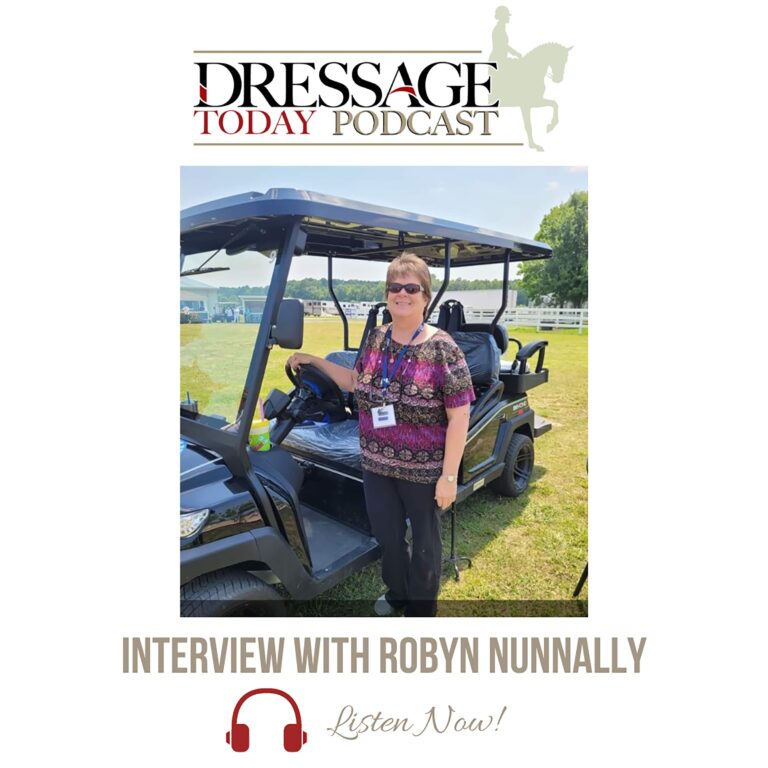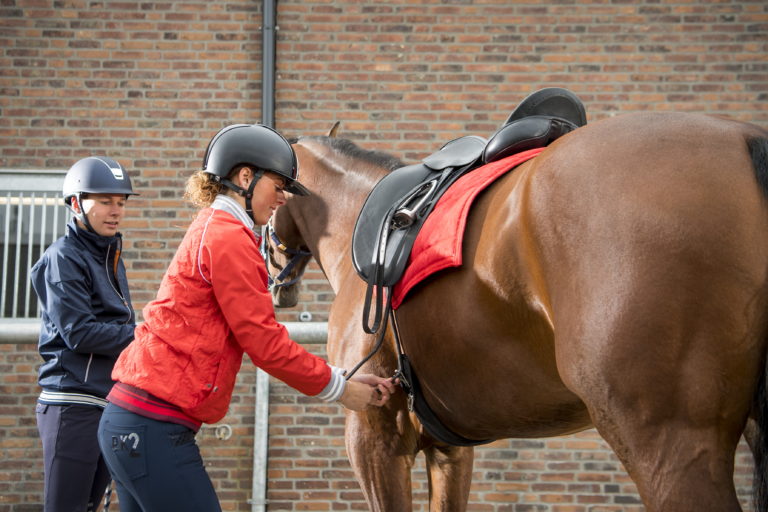Looking to develop a deeper seat? Then perhaps riding without stirrups this month is right for you. If you’re not already accustomed to riding without stirrups, make sure to do so on a suitable schoolmaster type and consider having a trainer or a friend assist you.
Since we all wish to be supple, adaptable riders with independent seats, no stirrup work, if done the right way, can serve as a valuable tool. Perhaps something new to add to your repertoire, or an old tool to revisit.
Done the right way?
Riding without stirrups, or with long stirrups, might help you find a deeper seat, but be careful to not end up gripping and therefore developing seat faults. A common problem when riding without stirrups is that many riders inadvertently grip with their thighs and push themselves out of the saddle. This can cause other seat issues such as tight hips, strong hands, fetal response, leaning back, rigidly bouncing, holding of breath, etc. We must learn to breathe and let go.
Why is it difficult to let go?
Humans are bipeds designed to move and balance over our legs, i.e. standing. We are all born with the fear of falling and injuring our head, so we learn to stand up and walk. Sometimes this fear is difficult to overcome, but that same fear is actually a blessing as it keeps us safe.
We might say that the sitting posture in riding is a hybrid of sitting and standing, but either way, we must unlearn the inate human instinct to find the ground (therefore safety and balance) with our legs. We learn to optimally give our weight into the saddle through a correctly aligned seat, which includes a mobile pelvis and softly draping legs.
Perhaps not for me?
If you find yourself too nervous, don’t do it. And if you have a young horse, an older horse, or a horse with a weak back, perhaps riding without stirrups is a poor choice all together. However, just about everyone on almost all horses can benefit from at least walking without stirrups. If your horse is safe but you find yourself not quite ready, consider trying safely dropping only one stirrup at a time and going for a walk.
A Month- Long Commitment
Whether you choose to participate in “No Stirrup November” or not, why not make a month-long commitment, at any time, to improve your seat? In addition to riding without stirrups, seat improvement and training can take many forms including lunge lessons, body awareness exercises, consulting with a biomechanics expert, reading up on the subject, taking courses to improve your riding from home or even taking up something seemingly unrelated, yet complimentary, like dancing. Find something that you enjoy.
General Tips
Move With your Horse
“Every single joint in the rider’s body must be relaxed to allow the rider to sit in a supple position and in balance with the horse. Only then can the aids be applied effectively.” (Principles of Riding, The Official Handbook of the German Equestrian Federation).
All joints must be relaxed and available to move. The horse’s center of gravity is not constant, and kinetic forces from the horse need to move through the rider. The rider can learn to filter this movement, but it has to go somewhere. Therefore, a supple seat is needed to allow a horse to move correctly over its back, without blocking the horse. Blocking the horse, albeit unintentionally, can lead to training issues like not pushing enough from behind, a dropped back, unsteady connection and “rein lameness.” A horse blocked by the rider can eventually develop soundness issues.
No such thing as a “Normal Seat”
In Gustav Steinbrecht’s highly regarded classic, The Gymnasium of the Horse, the author states: “A ‘normal seat’ on the horse, even if in the majority of cases this means only a posture that is correct, does not exist at all because the rider sits the horse correctly only if his center of gravity, or rather the line of the center of gravity of his body, coincides with that of the horse.” This book is one of the most influential texts and a foundation within the German classical school.

Think Movement, Not Posture
Two More Tips from the German Equestrian Federation:
- “The pelvis, hip-joints and thighs must move with the horse’s movements. This is the most important precondition for a correct seat. By elastically relaxing and contracting the muscles of the trunk, the rider can maintain a deep, supple, balanced seat. Only then can he really ‘feel’ the swinging of the horse’s back and the springy activity of the hindquarters.”
- “If the rider is stiff through the pelvis, hips and thighs, this will interfere with, or even block, the activity of the horse’s back, As a result, the impulsion is restricted or prevented from passing from the hindquarters forward through the back to the poll and, likewise, the half-halts will be blocked. The horse will not ‘let the aids through’ in either direction.”
(Quotes used with permission, Principles of Riding, The Official Handbook of the German Equestrian Federation).
Pelvic Mobility = Harmony During Riding.
The above is clear, classical advice, and recent research supports these ideas. According to a research study published by MDPI and funded by the Danish Horse Levy Foundation, there is a direct relationship between rider pelvic mobility and harmony during riding. The study also helps riders understand what types of unmounted, mobilizing exercises can directly help improve their riding and see clearly that static, balancing exercises won’t positively influence riding performance, even though they might be helpful for other things or perhaps even considered healthy.
“It appears that the ability to actively move the pelvis is more relevant to equestrian performance than static balancing skill. Horses ridden by riders with better pelvic mobility and control showed significantly fewer conflict behaviors. On the contrary, high scores for balancing on the gymnastic ball were negatively correlated with the horses’ working heart rates, suggesting a less energetic performance. Pelvic control and mobility may be predictive for equestrian skills and riding harmony.”
 Mari Hafstad and her horse Artemis, Sweden
Mari Hafstad and her horse Artemis, SwedenDon’t Ignore the Science—Pelvic Mobility, Range of Motion of Trunk, Knees and Head
The scientific paper, “A Scoping Review of Determinants of Performance in Dressage” published in PeerJ, concludes that the rider’s pelvis is crucial for performance. Even more, the paper proves that timing and movement play key roles in performance.
“From this model it could be concluded that the posture and ROM (Range of Motion) of the rider’s pelvis, trunk, knee and head and, importantly, the timing of rider pelvic and trunk motion in relation to the movement of the horse, are likely to influence temporal, trunk motion and impulsion variables in the horse.”
Learn About Automatic Function in the Human Nervous System to Understand Positive and Negative Tension.
If we have difficulty breathing or feel unsafe (potential to fall due to lack of balance or support from underneath) our nervous system becomes alert, on the lookout for danger or even in a full state of alarm. This all might be very subtle, but the sympathetic nervous system (flight, fight, freeze) will be activated and undesirable seat faults like stiff hands, going into the beginnings of fetal-position, tight abdominal walls and other related automatic responses. Some riders may even become emotional or appear angry.
“To every emotional state corresponds a personal conditioned pattern of muscular contraction without which the emotional state has no existence.” Dr. Moshe Feldenkrais
It is not all about turning off the sympathetic nervous system (flight, fight, freeze). All athletics require a smooth interplay of the sympathetic and parasympathetic nervous systems while primarily remaining in a parasympathetic state.
Equestrian sport has the obvious extra challenge that our tension can cause tension in our horses. There are exceptions. If you have a “lazy” horse, getting your heart rate up, thinking about getting up to go somewhere, etc. can possibly help you.
Make Your Comfort A Priority
For the rider to sit in a supple position and in balance with the horse, the rider needs to be comfortable and let go of physical and mental tension. Without the rider finding her own comfort, extra effort and gripping occurs, which leads to a wobbly and unstable position.
From an unstable feeling, some riders automatically or deliberately attempt to stabilize by using even more muscular contraction or by jamming their heels down. This brings them further and further away from a supple seat where “every joint in the rider’s body must be relaxed.”
This will be a stiff/tight yet possibly outwardly “picture perfect” posture. Some riders will easily get out of breath, and their nervous systems will settle or unsettle somewhere between a state of readiness for danger or a full state of alarm.
“The aim of the Feldenkrais Method is a person that is organized to move with minimum effort and maximum efficiency, not through muscular strength, but through increased consciousness of how movement works.” Dr. Moshe Feldenkrais
Rewire Your Brain
“Neurons that fire together, wire together.” Neurons in the brain adapt during the learning process, a mechanism which is called neural plasticity. But let go of being a perfectionist and allow yourself to make mistakes. Making mistakes is a wonderful learning opportunity if you are self-aware.
Neuroplasticity is the human’s limitless capacity to learn and of the brain and nervous system to renew themselves and grow new connections. Although this ability is greatest in children, scientists in recent years have shown that neuroplasticity continues to function in adults as well. Best-selling author Dr. Norman Doidge writes that neuroplasticity represents “the most important alteration in our view of the brain since we first sketched out its basic anatomy.”
We know that neuroplasticity is stimulated through precise, directed attention to a wide variety of gentle and unusual movement possibilities so consider this when you are quietly exploring improving your seat.
 DTM Feldenkrais Awareness Through Movement Class, Poinciana Farm
DTM Feldenkrais Awareness Through Movement Class, Poinciana FarmAnd for at home based learning, visit https://www.davethindmethod.com to check out either DTM’s 14-Day Challenge “Unlock Your Hips & Swing With Your Back” or “60 Days To A Better Dressage Seat”, or the live “Improve Your Riding From Home” classes on zoom, endorsed by Christoph Hess, Charlotte Jorst and Dr. Hilary Clayton among others.
Dressage Today Members receive 10% off, using the promo code DRESSAGETODAY10. Discount applied at check out.
About Dave Thind

Born in Canada and trained in Germany, Dave Thind makes his home in Walpole, Massachusetts, as owner of Aspire Farm. Thind has himself competed at the Grand Prix level in dressage and jumping. He is a noted equestrian biomechanics authority, with several published articles and appearances as an expert guest or lecturer. By invitation from the German Equestrian Federation, he is currently writing a book for them. Dave received his German ‘Trainer A’ license in 2007 with a nearly perfect score awarded to him from the FN. He holds an International Trainer Passport Level III and is a Guild Certified Feldenkrais Practitioner®.











